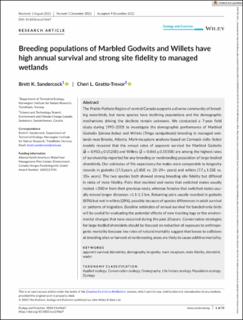| dc.contributor.author | Sandercock, Brett | |
| dc.contributor.author | Gratto-Trevor, Cheri L. | |
| dc.coverage.spatial | Prairie Pothole Region, central Canada | en_US |
| dc.date.accessioned | 2023-02-09T09:32:01Z | |
| dc.date.available | 2023-02-09T09:32:01Z | |
| dc.date.created | 2023-01-19T10:52:56Z | |
| dc.date.issued | 2023 | |
| dc.identifier.issn | 2045-7758 | |
| dc.identifier.uri | https://hdl.handle.net/11250/3049556 | |
| dc.description.abstract | The Prairie Pothole Region of central Canada supports a diverse community of breeding waterbirds, but many species have declining populations and the demographic mechanisms driving the declines remain unknown. We conducted a 7-year field study during 1995–2001 to investigate the demographic performance of Marbled Godwits (Limosa fedoa) and Willets (Tringa semipalmata) breeding in managed wetlands near Brooks, Alberta. Mark-recapture analyses based on Cormack–Jolly– Seber models revealed that the annual rates of apparent survival for Marbled Godwits = 0.953 ± 0.012SE) and Willets ( = 0.861 ± 0.015SE) are among the highest rates of survivorship reported for any breeding or nonbreeding population of large-bodied shorebirds. Our estimates of life expectancy for males were comparable to longevity records in godwits (17.3 years ±5.8SE vs. 25–29+ years) and willets (7.7 ± 1.5SE vs. 10+ years). The two species both showed strong breeding site fidelity but differed in rates of mate fidelity. Pairs that reunited and males that switched mates usually nested <300 m from their previous nests, whereas females that switched mates usually moved longer distances >1.1–1.5 km. Returning pairs usually reunited in godwits (85%) but not in willets (28%), possibly because of species differences in adult survival or patterns of migration. Baseline estimates of annual survival for banded-only birds will be useful for evaluating the potential effects of new tracking tags or the environmental changes that have occurred during the past 20 years. Conservation strategies for large-bodied shorebirds should be focused on reduction of exposure to anthropogenic mortality because low rates of natural mortality suggest that losses to collisions at breeding sites or harvest at nonbreeding areas are likely to cause additive mortality. apparent survival, biometrics, demography, longevity, mark recapture, mate fidelity, shorebird, wader Applied ecology, Conservation ecology, Demography, Life history ecology, Population ecology, Zoology | en_US |
| dc.language.iso | eng | en_US |
| dc.rights | Navngivelse 4.0 Internasjonal | * |
| dc.rights.uri | http://creativecommons.org/licenses/by/4.0/deed.no | * |
| dc.subject | apparent survival | en_US |
| dc.subject | biometrics | en_US |
| dc.subject | demography | en_US |
| dc.subject | longevity | en_US |
| dc.subject | mark recapture | en_US |
| dc.subject | mate fidelity | en_US |
| dc.subject | shorebird | en_US |
| dc.subject | wader Applied ecology | en_US |
| dc.subject | Conservation ecology | en_US |
| dc.subject | Demography | en_US |
| dc.subject | Life history ecology | en_US |
| dc.subject | Population ecology | en_US |
| dc.subject | Zoology | en_US |
| dc.title | Breeding populations of Marbled Godwits and Willets have high annual survival and strong site fidelity to managed wetlands | en_US |
| dc.title.alternative | Breeding populations of Marbled Godwits and Willets have high annual survival and strong site fidelity to managed wetlands | en_US |
| dc.type | Peer reviewed | en_US |
| dc.type | Journal article | en_US |
| dc.description.version | publishedVersion | en_US |
| dc.rights.holder | © 2023 The Authors | en_US |
| dc.subject.nsi | VDP::Matematikk og Naturvitenskap: 400::Zoologiske og botaniske fag: 480 | en_US |
| dc.source.journal | Ecology and Evolution | en_US |
| dc.identifier.doi | 10.1002/ece3.9667 | |
| dc.identifier.cristin | 2110090 | |
| dc.relation.project | Norges forskningsråd: 160022 | en_US |
| dc.relation.project | Andre: Alberta North American Waterfowl Management Plan Center | en_US |
| cristin.ispublished | true | |
| cristin.fulltext | original | |
| cristin.qualitycode | 1 | |

